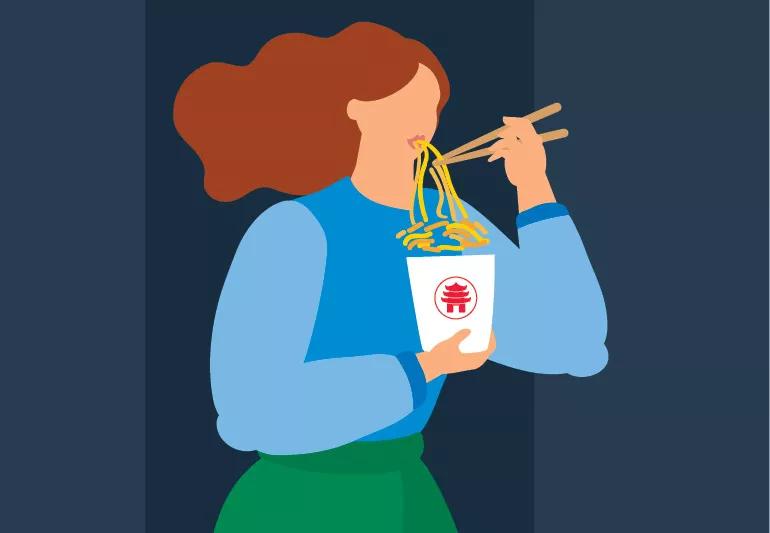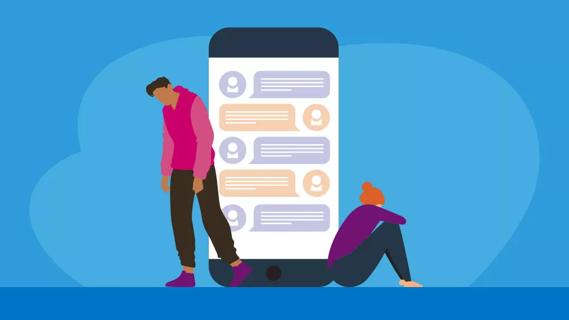Don’t let emotions trigger bad food habits

You stand at the freezer, steaming over a fight with your spouse and searching for some ice cream to cool your emotions. You sit on the couch and mindlessly munch through a whole bag of chips after a stressful day.
Advertisement
Cleveland Clinic is a non-profit academic medical center. Advertising on our site helps support our mission. We do not endorse non-Cleveland Clinic products or services. Policy
This is emotional eating. You might have heard it called “stress eating,” but “emotional” is more accurate, says registered dietitian Anna Kippen, MS, RDN, LD. Many negative emotions — including anger, sadness and stress — can trigger bad eating habits.
Here’s the problem: The feel-good foods you reach for can actually make you feel worse. Fortunately, there are strategies to help make sure your emotions don’t turn into diet damage in the long term.
A bad day at work or a fight with a friend are short-term issues. But emotional eating can stem from bigger issues, too. These include chronic stress, long-term anger, depression and other concerns. If these apply to you, you may benefit from counseling, stress management, exercise and other techniques.
The strategies outlined here can help. But ultimately, you need to identify and address the true source of your emotional eating.
When you walk to the refrigerator, pantry or vending machine, pause and ask a simple question: “Am I really hungry?”
Kippen suggests rating your hunger on a scale from 1 to 5, with one being you’re not hungry at all, and five being you’re so hungry that you would eat the food you hate most in the world.
“It’s too easy to just dive into mindless eating, but by asking yourself this question, you at least recognize your motivation,” she says.
Advertisement
If your hunger clocks in at a level three or four, she suggests grabbing a healthy, balanced snack within 15 minutes or a healthy, balanced meal within 30 minutes. If your physical hunger is lower than that, she recommends trying an alternative activity like drinking a cup of fruity herbal tea or going for a walk.
“Becoming more aware of your hunger level can help you to curb excessive snacking and make better choices,” she says.
If you don’t have a giant bag of greasy chips at your fingertips, you can’t eat the whole bag. That’s good, because overeating processed snacks can raise your levels of the stress hormone cortisol.
If you need a salty snack, stock popcorn (with salt and oil only) instead. You’ll get the whole grains that are one important source of the feel-good hormone serotonin. You’ll also get antioxidants to boost your immune system and far fewer calories than chips. Roasted chickpeas are another great crunchy option with protein and fiber to fill you up.
If stress, anger or sadness trigger your sweet tooth, remember this: The sugar high comes with a low afterward. This low can lead to increased cravings later. And, sweets and processed foods can even make certain mental concerns, including symptoms of depression, worse.
As an alternative to your favorite candy, cake or pies, Kippen recommends keeping a bowl of sweet fruit out in the open. (Studies show you’re more likely to eat fruits and veggies when they are easy to access).
“I also suggest keeping frozen berries on hand that can quickly be thrown into a blender to make a healthy sorbet,” she says.
Have you ever wondered why people offer hot tea in emotional situations? It turns out there’s more to it than soothing steam. Tea often contains helpful antioxidants. And green tea, matcha tea and white tea contain an amino acid called L-theanine that may help reduce stress levels.
If you tend to snack late at night, try dark cherries. Not only do they offer a sweet treat, but they also help increase natural levels of melatonin to help you sleep. Likewise, salmon and other fish rich in omega-3 fatty acids may help with sleep.
The list goes on: Dark chocolate (at least 72% cacao), whole grains, nuts, legumes, and fruits and vegetables all have a part to play in maintaining a healthy mind. “The key is stocking up on foods that help with your stress or emotions, and avoiding processed junk that might make you feel worse,” Kippen says.
If you’re prone to stress-related snacking, prepare for it.
For example, don’t eat any food straight from the package. Grabbing snacks from the package is a recipe for binge eating and overindulgence.
Instead, pre-portion snacks such as nuts, popcorn or sliced veggies into baggies or containers. Consider these your emergency snack packages — or just your healthy snack options on an ongoing basis.
Advertisement
Beyond these tips, it bears repeating: If you need medical help to address emotional issues, ask for it. A doctor can help you tackle stress, depression, anger or any other negative emotions with a full treatment plan.
Advertisement
Learn more about our editorial process.
Advertisement

An obsession with eating ‘clean’ or ‘healthy’ can be both physically and emotionally damaging

Eating disorders are diagnosable mental health conditions, while disordered eating is unhealthy eating behavior that doesn’t meet the criteria for a diagnosis

This is an eating pattern that doesn’t meet the criteria for an eating disorder but can still be harmful

Having overweight and disordered eating is a high-risk combination that often gets dismissed or overlooked

While social media content doesn’t create eating disorders, it can easily exacerbate them

Get moving, avoid the scale and be kind to yourself — plus, learn your triggers

It may be mistaken for digestive problems

They cause junk food cravings at night

The best parenting style balances enforcing rules and showing plenty of love

Tips include cutting back on sugar, focusing on exercise and managing stress

It can be harder to let go when you’ve invested time, energy and emotions — but it might be the healthier choice long term